Hothfield's Lost Railway Station
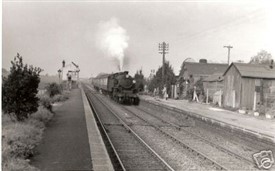
A train on the down line towards Ashford
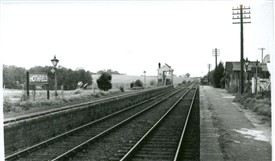
View from the down platform looking towards Maidstone East. Signal box in the distance.
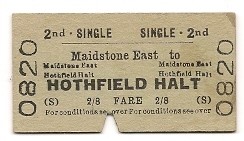
One of the last Hothfield Train Tickets issued, dated 1959
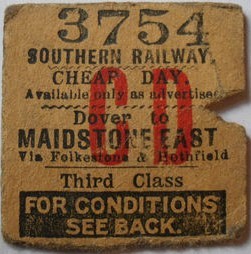
Dover to Maidstone via Hothfield in 1928
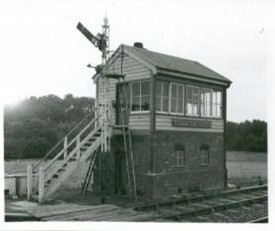
Hothfield Signal box to manage traffic in and out of the sidings
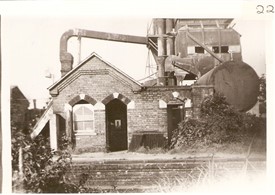
Tarmac plant with station buildings

Free exhibition 25 March to 27 April
The rise and fall of Hothfield Station, in Westwell
By Chris Rogers
The railway line between Maidstone East and Ashford was opened in 1884 by the London Chatham and Dover Railway company. The Ashford International Model Railway Education Centre (AIMREC) is running a collection of exhibitions across Ashford in April 2024 year to celebrate 140years of history of the line.
The other line, through Pluckley, had been opened much earlier, in 1842, by South-Eastern Railway, and was easily accessible to the residents of Hothfield. And in September 2003 the ‘High Speed 1’, or Channel Tunnel Rail Link (CTRL) as it was then known, cut through our parish requiring the relocation of Yonsea Farm.
In the late 1800s the Lord Hothfield owned vast amounts of land around this entire area extending from south Ashford (the area we now know as Beaver Green and Shipwash Farm) across to Ripton Manor (as it was called then), Great Chart, Little Chart, Bethersden, Westwell and beyond. The South-Eastern railway had consumed 9 acres of his land. Legend says that when the London Chatham and Dover Railway Company approached the Lord to put another line across his estate he accepted on the agreement that a railway station would be built for Hothfield. Whether that story is true is yet to be researched. He is recorded in 1893 as being a director of the South-Eastern Railway (the rival to the Maidstone & Ashford line). The Ashford-Maidstone line doesn’t cross the parish of Hothfield but passes through Westwell, most of which Lord Hothfield owned. The station was called “Hothfield”, and not ‘Westwell’. The station was downgraded to a ‘Halt’ in 1937 but it was still staffed and had toilets. It was severely damaged when a bomb fell nearby during WWII which damaged the Station-master’s house and ticket office, although toilet blocks and shelters remained, and there was a signal box. The Kent Messenger described the ruins of the old station as an eyesore.
By 1953 eleven trains passed through the station daily and there were about twelve passengers each day. It was inevitable that Hothfield Halt was no longer needed and in 1959 it closed to passengers, and closed for freight in 1964.
Most railway stations had their own sidings for collecting and delivering goods, and many along the Ashford to Maidstone line still have them or remnants of their old sidings today. They all had cattle docks and these were sometimes known as ‘cattle sidings’ where local farmers could load their livestock to take to market in Ashford, Maidstone or maybe even to send goods further afield like London or Dover. Ashford West station had a Cattle Inspectors Office. Traditionally milk was collected from farmers along the line on the early morning train and taken to London for the population there, giving rise to the name for the early train as the ‘milk train’.
An account by one of the cowmen at Hothfield's manor (Hothfield Place) describes the emotional parting with his final herd of cattle before he retired from the estate in 1929. He loaded the Guernsey cattle onto the train to start their journey to their new owners. If that wasn't hard enough the big bull, his favourite beast, cried after him. Albert Woolley's emotional account of his life as dairyman ends "... it made me feel very downhearted. After all was over I felt quite done up; it was a dreadful blow to me parting with all my charges, and I shall never forget it. ... And so I come to the end of my life's work at Hothfield Place after nearly fifty years."
Hothfield’s sidings and a goods shed also served a roadstone and tarmac plant with wagons of stone, and of tar being shunted into the plant. The next door roadstone and tarmac plant had long been in existence, and if you’re wondering where the Station was then it’s the site of the current Tarmac plant on the road to Westwell which still survives. It is rumoured that a narrow platform was retained next to the rails and the early train in the morning stopped to allow the workers of the tarmac plant to get off; that’s another legend that needs to be researched. From an aerial photograph of 1961 the station’s buildings seem to have gone and in later years a new set of sidings were built on the location of where the station platform and buildings had been.
There were sets of points to allow trains to swap from one line to the other and Hothfield’s station had its own signal box so that these trains could be managed on and off the main line. The signal box lasted long after the station was demolished, but the current sidings are now controlled from Ashford.
The station had been used by the locals and also by the WWII soldiers based at the army camps across Hothfield who were being trained and preparing for war. The station was unmanned at weekends and during the night so the soldiers returning from a night out in Ashford could sometimes travel back from the town without buying a ticket.
Curiously some train tickets, such as the one pictured from 1928 for a journey from Dover to Maidstone, refer to ‘via Hothfield’. If Hothfield was such a small and insignificant station then why mention it on long-distance tickets? I think that because there were two railway lines heading west from Ashford (one via Charing and the other via Pluckley) then the tickets clarified that the journey was via Hothfield as being the first station west of Ashford – I guess that passengers at Ashford station needed to check that the train was going through Hothfield to ensure that they were on the right line to reach Maidstone East or other destinations.
The station buildings themselves were located on the ‘down’ side of the station, on the platform bound for Ashford. This is also true of Charing and Pluckley, so presumably customers in the early days mainly travelled to their nearest big town. Customers at Hothfield and Charing stations could wait in the ticket hall for their trains to Ashford, but if you were going to Maidstone or London then there was little shelter on the other side of the station. So I wonder what did Lord Hothfield do each time he went to his big house in London (or even travelled via London to other parts of his vast estates like Appleby)? The later Lords spent more time in London (and elsewhere) than in the manor at Hothfield. Surely he and his family and staff wouldn’t have waited on the open southern platform exposed to the weather? I wonder if the train was swapped to the other side of the station as it approached from Ashford, collected the party, and then swapped tracks back onto the ‘up’ line after he got on board?
The 140th Anniversary Exhibition runs at the Ashford Gateway Plus, Church Road, Ashford from 25th March to 27th April 9am to 5pm (closes 3pm on Saturdays). Entry is free and there will be several panels about Hothfield, the CTRL, the Nissen Huts and the manor at Hothfield Place. See: www.aimrec.co.uk for more information and for details of their model railway displays across Ashford on 6th and 7th April 2024.